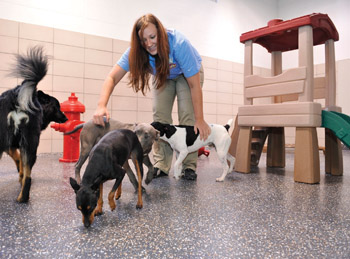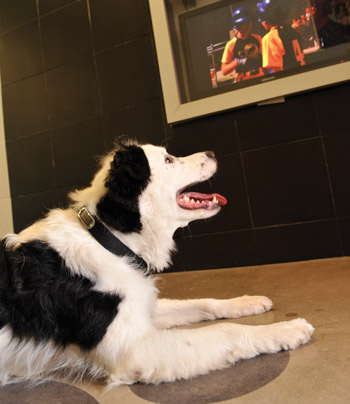
Two Decades of Remarkable Change
A view of the evolution of the pet care business
from an industry pioneer
By Joan Nieman
This summer, Best Friends Pet Care marks its 20th anniversary. It’s an occasion to reflect upon the evolution of the pet care business in recent decades and to consider how what we’ve learned can help us prepare for the decades to come.
Personally, I find it remarkable how dramatically our industry has changed. Think back 20 years: could any of us have predicted that pet owners would be demanding social play sessions, special holiday meals, or luxury suites with televisions for their dogs? For us at Best Friends, it’s both exciting and humbling to see the role our company played in bringing about those changes.
Our founders were pioneers. At a time when people were more likely to leave their pets with a friend than at a boarding kennel, they had the vision to launch a national hotel chain for pets – believing they could win over pet owners if they offered standardized care and service under a recognizable brand name.
They were right. Today, Best Friends has 42 pet care centers across the U.S., including at Walt Disney World® Resort in Florida, and pet parents have entrusted us with the care of their dogs and cats for more than 14 million pet nights over the past two decades.
The Evolution of the Family Pet

Interest in social play groups, like this doggy day camp session at Best Friends Pet Care, has exploded over the past decade.
The evolution of our industry really reflects how the role of the family pet has changed. I grew up at a time when the family dog lived in a dog house in the backyard, because pets were expected to be outdoors. They were permitted into the house only on special occasions; in the event of really severe weather, they might stay in the garage or basement.
By the time I had my own home, the family dog had moved into the house. We might still have a dog house out in the yard, but its main use was for shade on a sunny day. Our pets slept in the house – although certainly not on the furniture!
Today, pets sleep in our beds, eat beside our table, and even go on vacations with us. They have transformed from “animals” to family members in little more than a generation.
How the Business Has Changed
When I started my business, the pet services industry was simple: basic boarding, some grooming, and perhaps some training. Pet food was the main retail item, and retail was small.
Gradually, pet owners began to show interest in certain extras – playtimes, walks, Kong treats – and were willing to pay extra for them. There was demand for more and more interesting retail, especially plush toys and specialty treats.
In 1996, when Best Friends opened its flagship location in Norwalk for its “next generation” pet care center – an all-indoor, in-town center with extra services and amenities – many in the industry wondered if we had over reached.
I think it was the emergence of doggy day camp/daycare programs that marked the major turning point for our industry. Best Friends launched their program in 1996 and saw the concept quickly gain traction – especially with career couples who relished the idea of coming home from work to a tired dog instead of one ready for activity after sleeping all day. Once pet parents were sending their canine kids to camp, demand for other services and amenities followed.
Listening to the Client

Some pet parents want all the comforts of home for their canine kids, and are willing to pay for those extra, like these in-suite TVs at Best Friends at Walt Disney World Resort.
In 2001, we conducted the first in a series of trend surveys designed to uncover changing pet owner attitudes about the care of their pets. We invited pet owners to help us “design the kennel of the future” with questions about location, room size, services, preferences for making reservations, and interest in special amenities.
These snapshots of pet owner opinions were surprising. Over just three years, we saw demand for play groups during boarding climb from less than 50% of the respondents (in 2001) to 68% by 2004. Interest in “luxury” accommodations (special bedding, TVs, larger rooms) grew from 16% to 24% of respondents. With the growth of technology, the desire for online booking jumped to 45% while the demand for webcams hit 48% by 2004.
Those surveys were spot-on in predicting what was to come. We’ve all seen the new breed of pet owner in our businesses. They expect their pets to have all the comforts of home when they board – from ice cream treats and holiday meals to televisions and bedtime stories. They want group socialization and play opportunities to be standard. They insist on making and modifying reservations online, and demand the ability to look in on their pet from their computers and smart phones.
What’s Next?
There’s no sign that the demand for customized care will trail off anytime soon. It stayed strong despite the economy. My “crystal ball” suggests that there are some other trends that will be important to our business in the balance of this decade:
- Social media. This new generation of pet owners grew up on Facebook, Twitter, and online review sites. If we aren’t interacting with clients in the digital world, our business doesn’t exist for them.
- A changing employee pool. The new entry-level employees are part of The Millennials Generation. This new generation has a vastly different world view – one that doesn’t respond to old-style management. We need to educate ourselves about them and how to train and motivate them if we want our businesses to thrive.
- Legislation on the legal status of pets. There is a growing movement to change the legal relationship from pet-owner relationship to pet-guardian. This has broad implications for how we will do business in the future.
Learning from the Past
Staying abreast of the trends is important, but it’s only part of the puzzle. If there is anything we learned from the past two decades, it’s that building and maintaining relationships is central to our success. Even in this “digital age,” the pet care business is still about relationships, so here is my plan for helping us survive and thrive over the next two decades.
- Take good care of existing customers. Reward them for their loyalty. After all, they sustain our business and are our best brand advocates.
- Never stop looking for new customers. People are more transient than ever before, and our best client could move across the country tomorrow. Finding clients with new puppies or kittens is like striking gold because of the potential for 12 or more years of business.
- Keep an attorney on retainer. Society is more litigious than ever before; sound legal advice from someone who knows our business will help us avoid costly proceedings.
- Have a good veterinary liaison. Pet health issues are inevitable in our business, and we need expert help when they arise.
- Never stop listening to customers. Keeping our ears open allows us to stay abreast of their expectations. Besides, they can be the source of great ideas for new service offerings that will help grow the business.
Joan Nieman, Vice President of Operations for Best Friends Pet Care, has more than 30 years of experience in the pet care industry. Prior to joining Best Friends in 1994, she owned and operated The Pet Resort in Oklahoma for a decade and has been active on industry associations, including serving on the board of the Pet Care Services Association.


